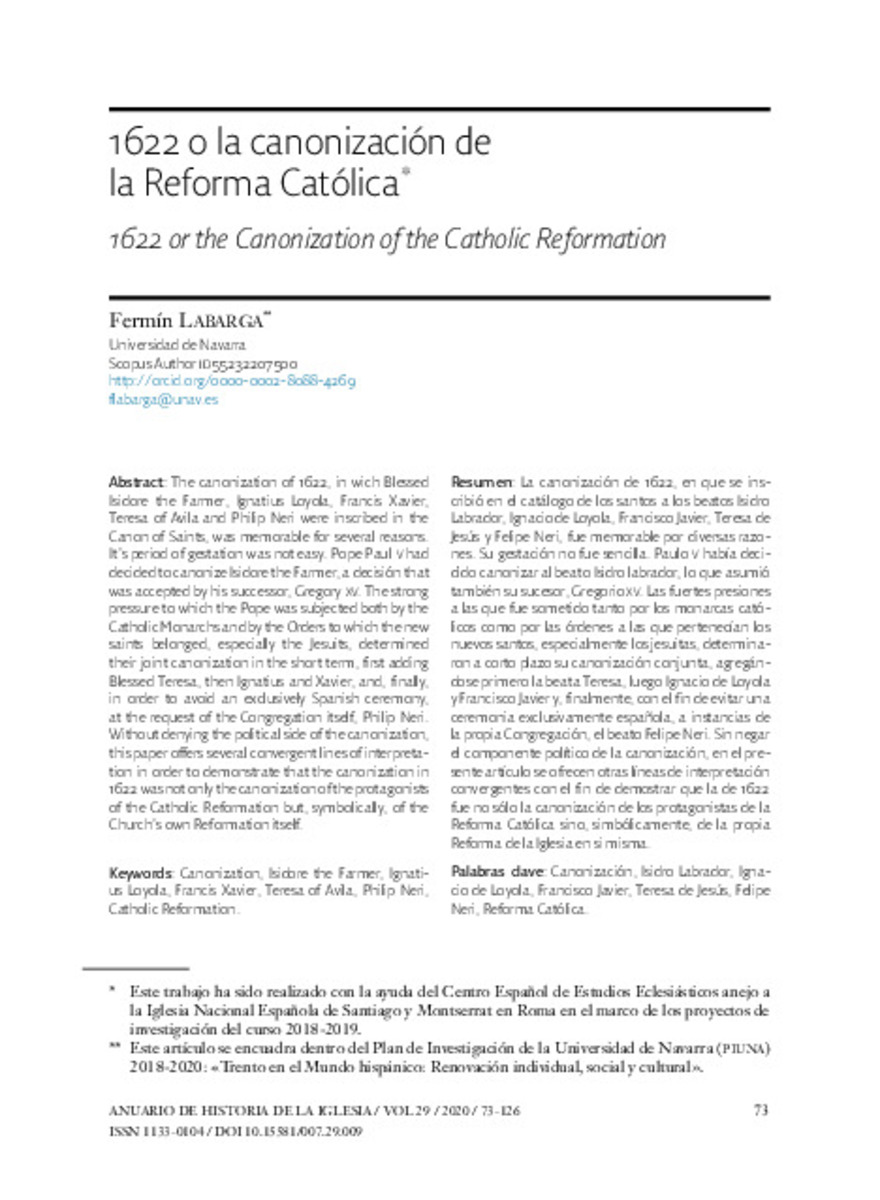Full metadata record
| DC Field | Value | Language |
|---|---|---|
| dc.creator | Labarga-García, F. (Fermín) | - |
| dc.date.accessioned | 2020-05-15 | - |
| dc.date.accessioned | 2021-05-19T10:57:26Z | - |
| dc.date.available | 2021-05-19T10:57:26Z | - |
| dc.date.issued | 2020 | - |
| dc.identifier.citation | Labarga-García, F. (Fermín). "1622 o la canonización de la Reforma Católica". . 29, 2020, 73 - 126 | es |
| dc.identifier.issn | 1133-0104 | - |
| dc.identifier.uri | https://hdl.handle.net/10171/60548 | - |
| dc.description.abstract | The canonization of 1622, in wich Blessed Isidore the Farmer, Ignatius Loyola, Francis Xavier, Teresa of Avila and Philip Neri were inscribed in the Canon of Saints, was memorable for several reasons. It’s period of gestation was not easy. Pope Paul v had decided to canonize Isidore the Farmer, a decisión that was accepted by his successor, Gregory xv. The strong pressure to which the Pope was subjected both by the Catholic Monarchs and by the Orders to which the new saints belonged, especially the Jesuits, determined their joint canonization in the short term, first adding Blessed Teresa, then Ignatius and Xavier, and, finally, in order to avoid an exclusively Spanish ceremony, at the request of the Congregation itself, Philip Neri. Without denying the political side of the canonization, this paper offers several convergent lines of interpretation in order to demonstrate that the canonization in 1622 was not only the canonization of the protagonists of the Catholic Reformation but, symbolically, of the Church’s own Reformation itself. | en_US |
| dc.description.abstract | La canonización de 1622, en que se inscribió en el catálogo de los santos a los beatos Isidro Labrador, Ignacio de Loyola, Francisco Javier, Teresa de Jesús y Felipe Neri, fue memorable por diversas razones. Su gestación no fue sencilla. Paulo v había decidido canonizar al beato Isidro labrador, lo que asumió también su sucesor, Gregorio xv. Las fuertes presiones a las que fue sometido tanto por los monarcas católicos como por las órdenes a las que pertenecían los nuevos santos, especialmente los jesuitas, determinaron a corto plazo su canonización conjunta, agregándose primero la beata Teresa, luego Ignacio de Loyola y Francisco Javier y, finalmente, con el fin de evitar una ceremonia exclusivamente española, a instancias de la propia Congregación, el beato Felipe Neri. Sin negar el componente político de la canonización, en el presente artículo se ofrecen otras líneas de interpretación convergentes con el fin de demostrar que la de 1622 fue no sólo la canonización de los protagonistas de la Reforma Católica sino, simbólicamente, de la propia Reforma de la Iglesia en si misma. | es_ES |
| dc.language.iso | spa | - |
| dc.publisher | Servicio de Publicaciones de la Universidad de Navarra | es_ES |
| dc.rights | info:eu-repo/semantics/openAccess | es_ES |
| dc.subject | Canonización | - |
| dc.subject | Isidro Labrador | - |
| dc.subject | Ignacio de Loyola | - |
| dc.subject | Francisco Javier | - |
| dc.subject | Teresa de Jesús | - |
| dc.subject | Felipe Neri | - |
| dc.subject | Reforma Católica | - |
| dc.title | 1622 o la canonización de la Reforma Católica | es_ES |
| dc.title.alternative | 1622 or the Canonization of the Catholic Reformation | en_US |
| dc.type | info:eu-repo/semantics/article | es_ES |
| dc.identifier.doi | 10.15581/007.29.009 | - |
| dadun.citation.endingPage | 126 | - |
| dadun.citation.startingPage | 73 | - |
| dadun.citation.volume | 29 | - |
Files in This Item:
Statistics and impact
Items in Dadun are protected by copyright, with all rights reserved, unless otherwise indicated.






